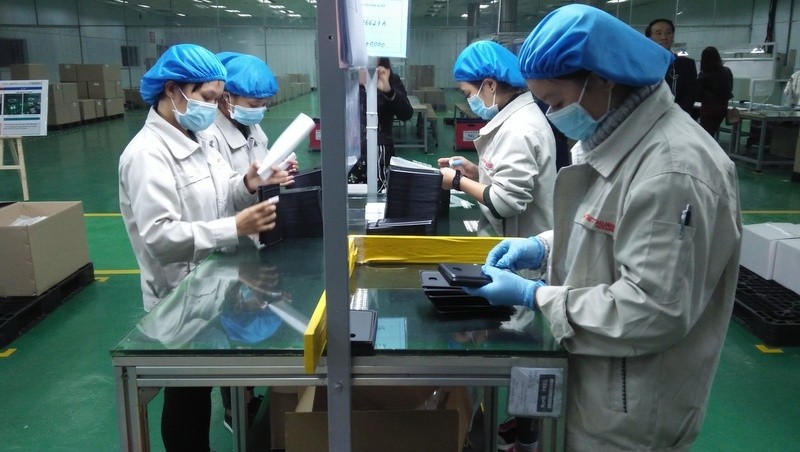Fitch Solutions under Fitch Ratings, one of the world’s largest rating agencies, a few days ago released its Asian economic report, stating that foreign direct investment (FDI) which focuses largely on the manufacturing and processing, will likely remain robust over 2019.
“We continue to project the Vietnamese economy to be a regional outperformer as we forecast growth to come at 6.5% in 2019, compared with an aggregate of 6.1% for Asia,” read the report. “We believe that FDI inflows into the manufacturing sector will be further supported by improved diplomatic relationships combined with the government’s open-door trade policy, alongside favourable demographics, such as Vietnam’s educated and low-cost labour force.”
According to statistics from the Ministry of Planning and Investment, the processing and manufacturing sector, which contributes to 80% of the Vietnamese industrial sector’s growth, remains the largest sector for FDI in 2018, with a total registered capital of US$16.6 billion in 2018, up 4.4% from US$15.9 billion in 2017.
In the first seven months of 2019, the FDI-driven manufacturing and processing sector attracted 713 projects registered at more than US$6 billion. Total newly-registered and newly-added capital, and capital acquisitions were worth US$14.46 billion, up from US$9.62 billion in the same period last year.
As of July 20, 2019, Vietnam had 29,247 foreign-invested projects registered at nearly US$352.3 billion. In the first seven months of this year, foreign-related stake acquisitions and capital contributions were valued at US$8.52 billion, up 77.8% on-year. FDI disbursement is estimated to hit US$10.6 billion, up 7.1% on-year.
Standard Chartered Bank last week released its fresh forecasts that Vietnam will “remain the fastest-growing ASEAN economy in the near term, with 2019 growth being projected at 6.9%. The FDI-driven manufacturing sector, which is poised for a fourth consecutive year of double-digit growth, will continue to be a key growth driver.”
According to the bank’s latest macro-economic research report, FDI inflows will stay robust this year, particularly in regards to the manufacturing sector, totaling US$18 billion.
Under the General Statistics Office’s recent survey on the trend of manufacturing and processing enterprises in Vietnam in the second quarter of 2019, 52% expected that their performance will get better in the third quarter while only 11.4% believed they will run into difficulties. Some 45.2% said their second-quarter performance was better than in the first quarter, and only 16.5% claimed that they faced difficulties.
The economy grew 6.76% in the first half of 2019, lower than the 7.05% rise in the same period last year. However, it still demonstrates an upbeat outlook for the economy as it remains far higher than the average growth rate of 5.53% in the 2011-2017 period. It also affirms the timeliness and effectiveness of the government’s solutions in socio-economic development.
Raymond Mallon, senior economic advisor from the Australia-Vietnam economic reform programme, said that FDI has had great impacts on Vietnam’s economic growth in the last 30 years, especially transforming the country’s manufacturing and processing sector.
Living in Vietnam over these decades, he has seen FDI help transform Vietnam from a low income, commodity-based economy, to an increasingly more dynamic mixed economy via the transfer to technology, capital, skills, know-how, and access to international markets.
“This has helped accelerate growth in productivity, incomes and living standards, and resulted in an unprecedented reduction in levels of poverty,” Mallon said.
The economy has become more diversified with a shift away from a dependence on unprocessed commodities, to the assembly and production of increasingly more sophisticated manufactured goods. FDI has also helped to build international quality tourism, education and health services.
“More generally, FDI is helping to enhance the visibility and reputation of made-in-Vietnam products and services in international markets,” he said. “FDI has also contributed to increased tax revenues, helping Vietnam to move towards more sustainable public sector financing, and facilitating increase expenditure on essential public services and infrastructure.”
Vietnam boasts a large low-cost labour with a relatively strong and inclusive basic education system, and a rapidly growing middle-income consumer market. The country’s geographic proximity to rapidly growing economies, combined with political and economic stability, an improving regulatory environment for investment and trade, and a strong commitment to support individual advancement and innovation are also important factors.
The “icing on the cake” for FDI is the growing access to international markets generated by Vietnam’s growing participation in existing and proposed international economic cooperation agreements, notably the ASEAN Economic Community, the Comprehensive and Progressive Agreement for Trans-Pacific Partnership, the EU-Vietnam Free Trade Agreement, and the Regional Comprehensive Economic Partnership. The recently signed and proposed agreements are expected to provide an important additional stimulus to FDI flows into Vietnam.
According to Fitch Solutions, Vietnam’s strong economic growth outlook will also continue to attract FDI in the real estate sector as foreign developers look to capitalise on the rising affluence of the population and the desire for physical expansion among businesses. Real estate businesses attracted a total FDI of US$6.6 billion in 2018, more than doubling the US$3.1 billion in 2017.
















